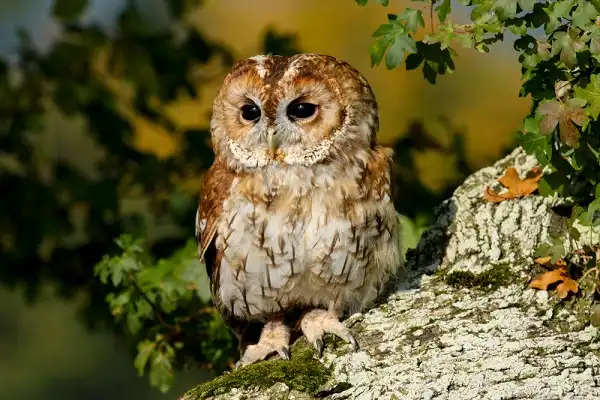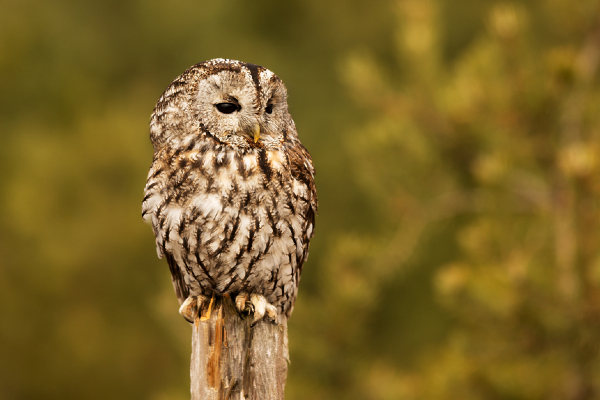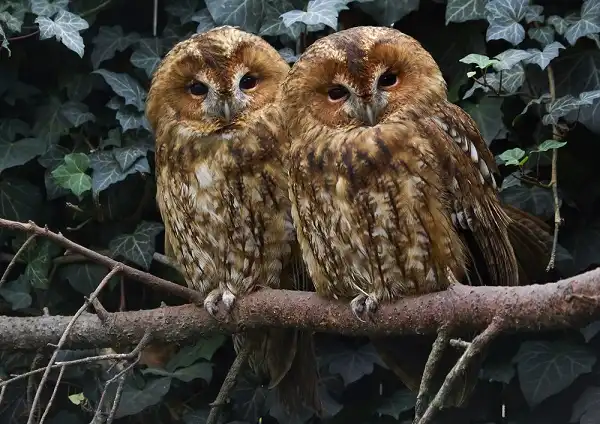The tawny owl is a medium-sized, brown owl found in Eurasia and North Africa. It is the most common owl in the U.K., where it is known as the “screech owl.” Despite its wide distribution, little is known about this elusive bird. In this post, we will take a closer look at the tawny owl, including its physical features, behavior, diet, and conservation status. Let’s get started!

Tawny Owl Description
The tawny owl is a distinctive and beautiful bird native to Europe and Asia. With its striking brown feathers, large, rounded head, and bright yellow eyes, it is easily recognizable by any experienced birdwatcher. Tawny owls are known for their characteristic hooting call, which has made them a common sight in many wooded areas throughout their range. They typically prefer nesting in tree hollows or rocky ledges, though they are also known to build nests in less protected places such as nest boxes provided by humans. Because of their nocturnal habits, tawny owls are adept at hunting their prey in the dark of night. With both keen hearing and sharp eyesight, they are able to hunt small rodents, voles, and insects with stunning precision. Whether observed up close or from a distance, the tawny owl is sure to capture the attention of all those who encounter it.
Tawny Owl Habitat
Tawny Owls are found in woods, parks and gardens throughout the UK. They are mainly nocturnal, so are most often seen at night. Tawny Owls get their name from their reddish-brown feathers. They usually nest in a tree hole or crevice, and will sometimes use an old nest made by another bird species.

Tawny Owl Diet
Tawny Owls are nocturnal predators that hunt a variety of small prey, including rodents, birds, and insects. Their diet can vary depending on the availability of food sources, but Tawny Owls will typically eat whatever is most abundant. In winter months, Tawny Owls will often take advantage of frozen ground to access voles and other small mammals that would otherwise be out of reach. Tawny Owls will also consume significant numbers of earthworms, which they are able to locate using their acute hearing. While Tawny Owls are capable hunters, they are also opportunistic feeders and will readily take advantage of an easy meal, such as roadkill. As a result of their varied diet, Tawny Owls play an important role in controlling local populations of small mammals and invertebrates.
Tawny Owl Size
Tawny owls are medium-sized birds of the typical owl family. They typically have wingspans of between 39 and 45 inches and may weigh up to 1.63 pounds. Tawny owls are distinctively patterned, with brown and pale colors that help them blend in with their surroundings, making them difficult to spot. Their size and coloring makes tawny owls well adapted for hunting small animals and birds, which they do primarily at night.
Tawny Owl Lifespan
Tawny Owls can live up to 15 years in the wild and up to 20 years in captivity if given proper care.

Tawny Owl Behavior
Tawny Owls are nocturnal hunters that use their excellent hearing and silent flight to capture prey. Tawny Owls will typically eat 1-3 times a day and can consume up to 3 times their body weight in a single day. Tawny Owls typically mate for life and will maintain a large territory around their nest site. Nest sites are typically located in tree cavities or on ledges. Tawny Owls will often use the same nest site for many years. Females will lay 2-5 eggs which hatch after about 28 days. The young owls fledge at about 6 weeks of age but will continue to be fed by their parents for several months.
Tawny Owl Speed
Tawny owls are well-known for their ability to silently glide through the night sky, quietly swooping down upon unsuspecting prey below. Tawny owls boast impressive speeds and agility, with some scientists reporting that they can reach speeds of up to 50 km/h when diving into their prey. This remarkable speed helps Tawny owls to evade potential threats, such as other predators or fast-moving prey-like squirrels or rabbits. Additionally, Tawny owls frequently demonstrate incredible burst power during escapes and chases, which only further emphasizes the significant role that speed plays in this species’ survival and success. Whether zipping through the forest canopy, gliding through the night sky, or taking off from the ground in pursuit of prey or escape from danger, Tawny owl speed is a vital component of this bird’s extraordinary physiology and evolutionary success.

Tawny Owl Hunting
Tawny Owls are skilled hunters, and they use a variety of methods to capture their prey. One common hunting technique is known as perch-and-stare. The owl will perch on a high branch and scan the ground below for movement. When it spots an animal, it will swoop down and grab it with its sharp talons. Tawny Owls also use a method known as pounce-and-wait. In this case, the owl will quietly stalk its prey until it is within range. Then, it will pounce on the animal and kill it with a single Blow. Tawny Owls are successful hunters because they are able to adapt their hunting methods to suit the environment and the type of prey they are after.
Conclusion
The tawny owl is a common and widespread species of owl. It is found throughout much of the temperate and tropical world. In North America, it ranges from Canada to Mexico. Tawny owls are usually active during the night, but can sometimes be seen during the day. They feed on a variety of small mammals, birds, reptiles, amphibians, and insects. Tawny owls breed in late winter or early spring. The female lays two to four eggs in an abandoned nest or tree cavity. Both parents help to incubate the eggs and care for the young owlets. Tawny owls are protected by law in many countries.
Frequently Asked Question

